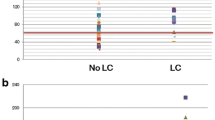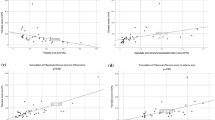Abstract
Although the Fontan operation can improve outcomes, surviving patients still face Fontan-associated liver disease (FALD). The aim of this study was to determine the associated factors of FALD in relation to ultrasound liver elastography. A cross-sectional study was conducted for all patients on whom an ultrasound upper-abdomen and ultrasound liver elastography was performed at more than 1 year after the Fontan operation. The data consisted of the age at operation, type of Fontan operation, and laboratory data such as gamma-glutamyl transferase (GGT), aspartate aminotransferase-to-platelet ratio index (APRI), and fibrosis-4 (FIB-4) score. Cardiovascular evaluations included echocardiography and cardiac catheterization. Eighty patients with a median age of 12 years (range 5–36 years) were eligible for the study. The prevalence of FALD was 41%. For the purpose of univariate logistic regression analysis, the age at the Fontan operation, time elapsed since the Fontan operation, previous Glenn shunt, presence of fenestration, mean pulmonary artery pressure and IVC pressure post-Fontan operation, platelet count, GGT, and FIB-4 score were considered to be factors significantly associated with FALD. Following an adjustment by multivariate logistic regression analysis, age greater than 7 years at the time of Fontan procedure, time elapsed of more than 9 years since the procedure, and GGT level > 130 U/L were found to be significantly associated with FALD. Patients with these factors should be investigated for FALD.



Similar content being viewed by others
References
Fontan F, Baudet E (1971) Surgical repair of tricuspid atresia. Thorax 26:240–248
D’Udekem Y, Iyengar AJ, Galati JC et al (2014) Redefining expectations of long-term survival after the Fontan procedure: twenty-five years of follow-up from the entire population of Australia and New Zealand. Circulation 130:S32–S38
D’Udekem Y, Iyengar AJ, Cochrane AD et al (2007) The Fontan procedure: contemporary techniques have improved long-term outcomes. Circulation 116:I157–I164
Agnoletti G, Ferraro G, Bordese R et al (2016) Fontan circulation causes early, severe liver damage. Should we offer patients a tailored strategy? Int J Cardiol 209:60–65
Hilscher MB, Johnson JN, Cetta F et al (2017) Surveillance for liver complications after the Fontan procedure. Congenit Heart Dis 12:124–132
Rychik J (2016) The relentless effects of the Fontan paradox. Semin Thorac Cardiovasc Surg Pediatr Card Surg Annu 19:37–43
Gewillig M, Goldberg DJ (2014) Failure of the Fontan circulation. Heart Fail Clin 10:105–116
Rychik J (2010) Forty years of the Fontan operation: a failed strategy. Semin Thorac Cardiovasc Surg Pediatr Card Surg Annu 13:96–100
Book WM, Gerardin J, Saraf A, Marie Valente A, Rodriguez F III (2016) Clinical phenotypes of Fontan failure: implications for management. Congenit Heart Dis 11:296–308
John AS (2015) Fontan repair of single ventricle physiology: consequences of a unique physiology and possible treatment options. Cardiol Clin 33:559–569
Goldberg DJ, Surrey LF, Glatz AC et al (2017) Hepatic fibrosis is universal following Fontan operation, and severity is associated with time from surgery: a liver biopsy and hemodynamic study. J Am Heart Assoc 6(5):e004809
Greenway SC, Crossland DS, Hudson M et al (2016) Fontan-associated liver disease: implications for heart transplantation. J Heart Lung Transplant 35:26–33
Fidai A, Dallaire F, Alvarez N et al (2017) Non-invasive investigations for the diagnosis of Fontan-associated liver disease in pediatric and adult Fontan patients. Front Cardiovasc Med 4:15
Diamond T, Ovchinsky N (2018) Fontan-associated liver disease: monitoring progression of liver fibrosis. Clin Liver Dis 11:1–5
Barr RG, Ferraioli G, Palmeri ML et al (2015) Elastography assessment of liver fibrosis: society of radiologists in ultrasound consensus conference statement. Radiology 276:845–861
Fitzpatrick E, Quaglia A, Vimalesvaran S, Basso MS, Dhawan A (2013) Transient elastography is a useful noninvasive tool for the evaluation of fibrosis in paediatric chronic liver disease. J Pediatr Gastroenterol Nutr 56:72–76
Ofei SY, Texter K, Gariepy C, Smith S, Zaidi AN, Phelps C (2019) Pediatric Fontan associated liver disease: non-invasive evaluation with serologic markers and acoustic radiation force impulse (ARFI) elastography. Progr Pediatr Cardiol 53:21–27
Lemmer JH, Coran AG, Behrendt DM, Heidelberger KP, Stern AM (1983) Liver fibrosis (cardiac cirrhosis) five years after modified Fontan operation for tricuspid atresia. J Thorac Cardiovasc Surg 86:757–760
Driscoll DJ (2007) Long-term results of the Fontan operation. Pediatr Cardiol 28:438–442
Evans WN, Winn BJ, Yumiaco NS et al (2014) Transvenous hepatic biopsy in stable Fontan patients undergoing cardiac catheterization. Pediatr Cardiol 35:1273–1278
Chen B, Schreiber RA, Human DG, Potts JE, Guttman OR (2016) Assessment of liver stiffness in pediatric Fontan patients using transient elastography. Can J Gastroenterol Hepatol 2016:7125193
DiPaola FW, Schumacher KR, Goldberg CS, Friedland-Little J, Parameswaran A, Dillman JR (2017) Effect of Fontan operation on liver stiffness in children with single ventricle physiology. Eur Radiol 27:2434–2442
Josephus Jitta D, Wagenaar LJ, Mulder BJ, Guichelaar M, Bouman D, van Melle JP (2016) Three cases of hepatocellular carcinoma in Fontan patients: review of the literature and suggestions for hepatic screening. Int J Cardiol 206:21–26
Téllez L, Rodríguez-Santiago E, Albillos A (2018) Fontan-associated liver disease: a review. Ann Hepatol 17:192–204
Horvat N, Rocha MS, Chagas AL et al (2018) Multimodality screening of hepatic nodules in patients with congenital heart disease after Fontan procedure: role of ultrasound, ARFI Elastography, CT, and MRI. AJR Am J Roentgenol 211:1212–1220
Author information
Authors and Affiliations
Corresponding author
Ethics declarations
Conflict of interest
None of the authors have any conflict of interest to declare.
Ethical Approval
All procedures performed in studies involving human participants were in accordance with the ethical standards of the institution.
Informed Consent
Informed consent was not required because of the retrospective study design.
Additional information
Publisher's Note
Springer Nature remains neutral with regard to jurisdictional claims in published maps and institutional affiliations.
Rights and permissions
About this article
Cite this article
Sethasathien, S., Silvilairat, S., Sittiwangkul, R. et al. Associated Factors of Liver Disease After Fontan Operation in Relation to Ultrasound Liver Elastography. Pediatr Cardiol 41, 1639–1644 (2020). https://doi.org/10.1007/s00246-020-02422-y
Received:
Accepted:
Published:
Issue Date:
DOI: https://doi.org/10.1007/s00246-020-02422-y




